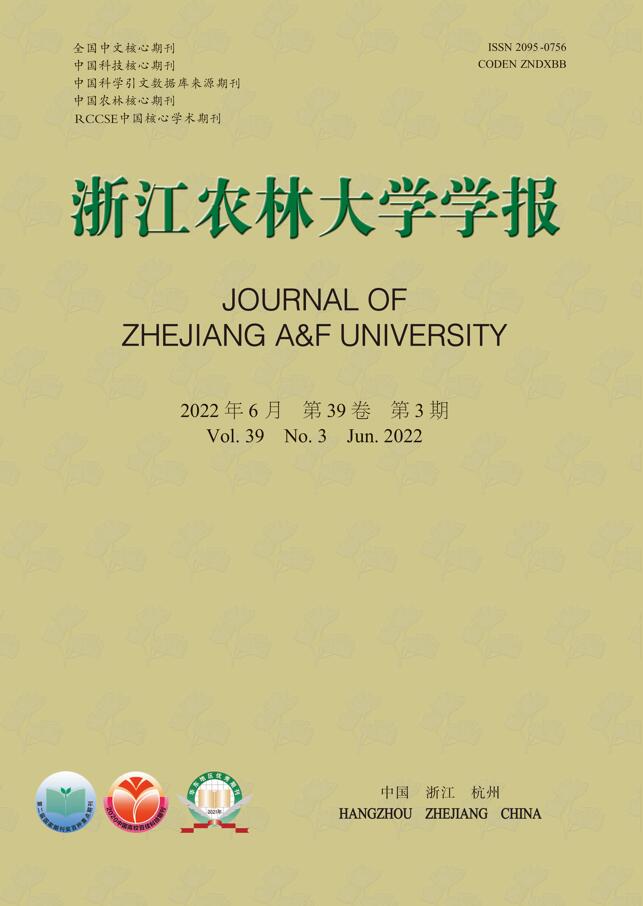-
桃潜叶蛾Lyonetia clerkella属鳞翅目Lepidoptera潜叶蛾科Lyonetiidae,又名桃叶潜蛾、吊丝虫,是桃树的主要害虫之一。其主要寄主是桃Prunus persica,其次是李P. salicina、杏Armeniaca vulgaris、樱桃Cerasus pseudocerasus、苹果Malus domestica、梨Pyrus spp. 和山楂Crataegus pinnatifida等蔷薇科Rosaceae核果类果树的叶片,在中国北京、山东、山西、云南等地均有分布[1-2],韩国、日本等也均有发生。近年来,在中国浙江省杭州市发生较为严重,果树生态效益及经济效益大为降低。被桃潜叶蛾为害的叶片破碎并从果树上提前脱落。在受害严重的果园里,7月桃树大量落叶,8月叶片基本落光,造成树势衰弱,果实产量和品质下降,甚至造成果园绝产,经济损失巨大[3]。桃潜叶蛾在桃树上的分布以上层为主,其次中层,下层分布最少[4]。日本已于20世纪70年代末开展对桃潜叶蛾生态学及生物学特性的研究。自1984年该虫的性信息素组分被分离和鉴定出后,中国、日本、韩国等均进行了性诱剂的相关研究。随着桃潜叶蛾为害程度的加重及发生面积的扩大,自1991年开始中国相关研究日益增多[5]。本研究主要对桃潜叶蛾的生物学特性、发生规律及防治方法进行了综述,旨在为今后该虫的可持续防治提供参考。
-
桃潜叶蛾为完全变态昆虫,一生经历卵、幼虫、蛹和成虫4个时期。卵:乳白色扁椭圆形(0.33~0.36 mm),孵化前变为褐色,壳薄且软[1],散产于叶背,卵期5~6 d。幼虫:念珠形(6.0~6.5 mm),胸淡绿色,头淡褐色,有黑褐色胸足3对,幼虫期8~12 d。蛹:乳白色(3~4 mm),腹部末端有2个圆锥形突起,其顶端各有2根毛,蛹期7~10 d。茧:白色,扁枣核型,2侧有长丝黏附于叶背或枝干表皮。成虫:体长3~4 mm,翅展6~10 mm。分为夏型和冬型2种生物型,夏型成虫银白色,表面光泽,具白色狭长前翅,近端部有一长卵圆形边缘褐色的黄色斑,斑外侧有4对斜形的褐色纹,翅尖端有1个黑斑,后翅灰黑色,披针形。冬型成虫前翅前缘基半部有黑色波状斑纹,其他同夏型。成虫期6~8 d,越冬代150 d以上[1-3]。
-
国内外对桃潜叶蛾的年发生世代数已有研究记录。桃潜叶蛾在中国的发生规律已基本明确,不同地区发生代数不同,自北向南1 a发生4~7代(表1)[5-9]。桃潜叶蛾主要以冬型成虫在落叶、杂草和树皮缝隙中越冬,少数以蛹在被害叶片上结白色丝茧越冬,这部分越冬蛹死亡率达13.9%~16.4%[10]。各地越冬成虫出蛰时间不尽相同,但基本在第2年桃树萌芽时开始出蛰,桃树展叶后开始产卵。该虫一般在7—8月随着气温升高,湿度增加,繁殖速度加快,种群数量激增,导致桃树被害严重,提前落叶。在韩国京畿道,桃潜叶蛾1 a发生7代,发生历时长达7个月[11]。在日本发生亦较为普遍,因各地区气温不同而有差异,自北向南1 a发生5~9代(表1)[12-17]。
地区 发生代
数/代第1代 第2代 第3代 第4代 第5代 第6代 第7代 第8代 越冬代 中国 辽宁大连 6 5月末至6月上旬 7月上旬 8月上旬 8月末至9月上中旬 9月末 10月末 山西晋中 5~6 5月下旬 6月下旬 7月下旬 8月下旬 9月中下旬 10月下旬 浙江奉化 7 4月中旬 5月中旬 6月中旬 7月中旬 8月下旬 9月下旬 10月下旬 北京平谷 6 5月上中旬 6月中旬至7月上旬 7月中旬 8月上旬 8月下旬 9月下旬 河北昌黎 6~7 5月上中旬 6月中旬 7月上旬 8月上旬 9月上旬 9月底 10月中旬 山东烟台 4 5月中下旬 6月下旬 8月上旬 10月初 甘肃秦安 5~6 4月下旬至5月上旬 6月中旬 7月中旬 8月中下旬 9月上中旬 10月初 四川绵阳 7 4月下旬 5月下旬 6月下旬 7月中下旬 8月中旬 9月末 10月末 新疆小海子
垦区6 5月中旬至
6月中旬6月中旬至
7月下旬7月下旬至
9月上旬9月上旬至
10月上旬10月上旬至
10月下旬11月初 日本 山形 7 5月上旬 6月下旬 7月中旬 8月上旬 8月下旬 9月下旬 10月末 茨城 8 4月下旬 5月下旬 6月下旬 7月中旬 8月上旬 8月末 9月下旬 10月下旬 鹿儿岛 9 5月上旬 6月上旬 7月初 7月中旬 8月初 8月中旬 9月上旬 9月下旬 10月末 韩国 京畿道 7~8 4月中旬 5月上旬 5月末 6月末 7月末 8月末 9月中旬 10月初 说明:中国辽宁大连、河北昌黎、四川绵阳为盛发期,其他地区为发生期 Table 1. Occurrence period of L. clerkella adults in different regions of China, Japan and ROK
-
桃潜叶蛾雌成虫交尾2~3 d后产卵,用产卵器将叶背表皮刺破,将卵产在刚展叶的嫩叶叶肉组织内,单粒散产,1个孔只产卵1粒。成虫产卵以幼嫩叶片为主,随着新梢生长,受害叶片逐渐上移。卵在叶肉组织内孵化,孵化后直接潜在叶肉内取食,并将粪便排泄其中,叶片外表可见弯曲虫道。初龄幼虫虫道较细,随着龄期增加虫道变粗。老熟幼虫从虫道末端咬破表皮爬出,吐丝下垂,在叶片背面结茧化蛹,有的在地面杂草作茧化蛹。
-
在中国北京平谷地区,当年11月中旬,平均气温6.5 ℃以下,桃潜叶蛾成虫潜伏越冬;次年3月上中旬,天气晴朗,风力不大,平均气温5.5 ℃以上时,成虫出蛰活动。冬型成虫交尾多在7:00后开始,平均交尾时间约5 h 12 min。夏型成虫多在叶背栖息,少量在叶面及枝干上。夏型成虫交尾多在6:00—9:00,交尾时间约11~24 min[18]。
-
桃潜叶蛾成虫有较强的趋光性,对黑光灯、白炽灯均有较强的趋性,黑光灯诱蛾量最多可达2600头·d−1。成虫具迁移能力,距离可达500 m以上。夏型成虫可转移为害,可从受害重的桃园转移到受害较轻的桃园继续为害[18]。越冬代成虫对糖醋液趋性较强,出蛰后有强烈的补充营养习性。3月中旬设置食诱剂可诱杀大量成虫[19]。
-
农业防治主要是恶化害虫的生存、繁殖环境,调节有益和有害生物的比例,压低虫害的发生基数,控制其繁殖和危害。对于桃潜叶蛾,冬季要实施清园,集中销毁果园内落叶、杂草,可消灭越冬成虫和蛹,减少虫源。除此之外,桃园附近不放置草堆、树枝垛,以免招致成虫在内越冬。受害较重的桃园,冬季要加强对病虫枝、伤残枝的剪除。刮除老树皮,尤其刮除有该虫越冬迹象的部位。刮后涂刷石硫合剂浆液,刮除的树皮集中处理[18]。
-
生物防治就是最大限度地发挥有害生物的生物控制因子作用,达到各种生物自然平衡的状态[20]。目前,主要应用性信息素、天敌昆虫、真菌等防治桃潜叶蛾。
-
性信息素是雌蛾性腺体分泌的微量化学物质,将其分离、鉴定并人工合成后可用于生物防治,干扰雌雄交配,有效降低下一代虫口数量,并且昆虫对此不会产生抗性,是一种可持续发展的防治技术。在生产实践上,利用性信息素可监测桃潜叶蛾的发生动态,确定田间防治的最佳时期,避免虫量基数过大导致后期难以控制。
桃潜叶蛾的性信息素组分已被分离和鉴定并用于田间试验。1984年,SUGIE等[21]鉴定出桃潜叶蛾性信息素的化学组成为14-甲基-1-十八碳烯(14-methyl-1-octadecene)。通过田间生物活性测定合成的14-甲基-1-十八碳烯和从桃潜叶蛾未交配雌蛾性腺体中分离的粗提取物具有同样的生物活性。由于14-甲基-1-十八碳烯中连接甲基支链的14号碳是手性中心,因此,1985年,SATO等[22]对光学纯的14-甲基-1-十八碳烯与生物活性的关系进行了研究,合成了(R)、(S)-14-甲基-1-十八碳烯,通过田间生物活性测定,证明(S)-14-甲基-1-十八碳烯的生物活性大约是(R)-14-甲基-1-十八碳烯的50倍。1986年,SATO等[23]最终证明在14-甲基-1-十八碳烯的2个旋光异构体中,只有(S)-14-甲基-1-十八碳烯具有生物活性。自桃潜叶蛾性信息素组分被鉴定以来,国内外进行种群动态监测及早期防控的研究已屡见不鲜[24-26]。在中国各个发生区,已有大量试验工作者先后在甘肃、四川、河北等地进行发生动态的监测研究。陈孝兰等[27]通过田间监测得出:在四川成都,桃潜叶蛾1 a发生7~8代,16~30 d完成1代。6—9月雨水集中,利于成虫羽化。在当地桃潜叶蛾发生初期即3月中下旬应开始悬挂诱捕器进行防治,将害虫密度控制在低发生量内。郝宝锋[28]在河北唐山监测到,桃潜叶蛾1 a发生5代,第3、4、5代即7月下旬、8月中下旬和9月上中旬为害较重,应于第1代成虫发生期即5月上旬开始利用性诱剂进行早期防治。利用性诱剂明确桃潜叶蛾的年发生动态,并对其进行适时防控可有效降低年发生量。
性诱剂作为生产上常用的生物防治措施,只有将其最大化利用,才能达到高效的防治效果。国内外已有研究表明:诱芯剂剂量、诱捕器类型、诱芯颜色等均能影响性诱剂的诱捕效果。陈玉琴等[29]进行了不同剂量(0.25、0.50、1.00 mg)和不同颜色(红色、绿色)的诱芯对桃潜叶蛾的诱捕效果试验,结果表明:1.00 mg剂量的诱芯活性最高,红色诱芯的诱蛾效果优于绿色。YANG等[11]在韩国也进行了不同剂量性信息素(0.1、0.5和1.0 mg)对桃潜叶蛾的诱捕效果试验,研究表明:剂量为1.0 mg的性诱剂诱蛾效果最好,但与0.5 mg相比没有显著差异。出于对成本的考虑,生产上推荐使用0.5 mg的性诱剂作为桃潜叶蛾的预测预报和早期防治。除此之外,诱捕器类型也是影响诱捕效果的重要因素之一。陈孝兰等[27]利用3种诱捕器(三角形诱捕器、船式诱捕器、白色黏板诱捕器)分别进行了田间试验,得出船式诱捕器诱蛾效果最好,分别是白色黏板诱捕器和三角形诱捕器的9.18和2.79倍。只有将影响性信息素诱蛾效果的因素全部考虑在内,并加以组合,才能最大地发挥生物防治效果。
高剂量的性信息素在桃园中对桃潜叶蛾会产生迷向防治的效果。ARAKAWA等[30]研究表明:经过迷向处理后的桃园与对照相比,能达到88%~100%的迷向率,且枝条被害数显著降低。由于昆虫性信息素具活性高、特异性强、使用简便、不污染环境、不伤天敌等优点,因此从食品安全和保护环境的角度出发,采用性信息素对害虫进行综合管理是可行的,也是未来可持续防治的一个重要方向[31]。
-
天敌的保护和利用是生物防治的重要部分,天敌包括捕食性天敌和寄生性天敌等。在田间大量放养人工饲养后的天敌,或将天敌固定在田间,均可将害虫密度控制在低水平上[20]。
桃潜叶蛾幼虫寄生性天敌有膜翅目Hymenoptera姬小蜂科Eulophidae,捕食性天敌有脉翅目Neuroptera草蛉属Chrysopa幼虫等,姬小蜂科天敌寄生率可达36.6%。桃潜叶蛾蛹天敌有膜翅目茧蜂科Braconidae、草蛉成虫,但寄生、捕食率很低。7月以后田间天敌开始增多,必须加以保护,尽量少用药或用选择性杀虫剂[32]。桃园地表覆盖苜蓿Medicago sativa作物有利于捕食性天敌的繁殖,可降低桃潜叶蛾密度,减少农药使用[33]。天敌种类和寄主密度均能影响寄生效果。RATHER等[34]进行了10种姬小蜂(Achrysocharoides sp.、Baryscapus sp.、Chrysocharis sp.、Chrysonotomyia sp.、Closterocerus sp.、Minotetrastichus sp.、Pnigalio sp.、Quadrastichus sp.、Stenomesius sp. 和Sympiesis sp. )对桃潜叶蛾幼虫的寄生率试验,结果表明:Chrysocharis sp.的寄生率最高,为47.8%,是次高Chrysonotomyia sp.的2.5倍。ADACHI[35]在日本茨城进行了不同寄主密度下桃潜叶蛾幼虫天敌寄生率的试验:在施用杀虫剂和未施杀虫剂的果园中,天敌的年寄生率分别约9.0%和19.0%。可见,天敌寄生率随着寄主密度的增加而提高。
-
毒蕈是对人和动物有毒的、不能直接食用的大型真菌,是有毒蘑菇的总称。自然界存在的很多毒蕈对某些昆虫有明显的抑制或毒性作用,可以将其用于农作物的生物防治[36-38]。已有文献记载:毒蕈对桃潜叶蛾幼虫、蛹及成虫具有抑制作用。杨永红等[39]利用4种毒蕈(稀褶黑菇Russula nigricans、黄粉牛肝Pulveroboletus rave、毒伞Amanita phalloides和硫磺菌Tyromyces sulphureus)进行了室内试验。结果表明:4种毒蕈对桃潜叶蛾幼虫均有抑制作用;对蛹的羽化无明显影响,喷施后羽化率均在90%以上;稀褶黑菇、黄粉牛肝、毒伞对成虫也有一定的诱杀效果,将其喷于黏板上与对照相比,可显著增加诱蛾量。室内试验表明:某些毒蕈对桃潜叶蛾的幼虫具有趋避、拒食作用,对成虫具有引诱作用。
-
桃潜叶蛾成虫群集飞行,有趋光性,灯光诱杀效果显著。用黑光灯诱杀成虫,放置30~45个·hm−2,每晚可诱杀成虫750~1 500头。在中国北京地区,成虫出蛰中后期对黑光灯表现出强烈趋性,诱杀数高于食诱剂和性诱剂。
-
中国耕地面积只有全世界的8%,但化学农药用量却占全球35%,为世界第1位。每年使用的化学农药高达100多万t。尽管化学农药的施用确保了农作物的丰产丰收,但不当使用引起的环境污染、农药残留超标等问题,迫使科研人员积极研发环境友好型农药[40]。对于桃潜叶蛾的防治,也迫切需要实现从化学农药向生物农药的转变。
自20世纪90年代以来,已有试验表明:2.5%功夫菊酯2500倍液[41]、1.0%甲维盐3000倍液[25]、灭幼脲3号1 500倍液[42]、天然除虫菊素1500倍液[43]、0.3%印楝素1 000倍液[44]等农药对桃潜叶蛾的防效较佳。在有机桃园中应将天然除虫菊素与印楝素等生物农药作为首选药剂。
利用农药防治桃潜叶蛾需注意施药时间、药剂种类和施药次数等。在第1代幼虫初孵化期施药,能有效控制后代虫口密度,并且应以施用高效低毒、低残留农药为主,如1.0%甲维盐3000倍液、0.3%印楝素1000倍液等。
-
从桃潜叶蛾发生至今,国内侧重于研究影响性诱剂诱捕效果因素和不同药剂对桃潜叶蛾防治效果[45],国外则侧重研究生物防治中的不同种类天敌对桃潜叶蛾的防治效果、天敌寄生率及寄主密度与寄主世代之间的关系[46-48]。
由于不同地区气候、地势存在差异,故桃潜叶蛾发生规律各有不同。各地果园应将害虫监测预警贯彻于整个生产过程中,及时掌握桃潜叶蛾的发生动态,明确其发生规律对高效长远综合防控的重要指导意义[27-28]。应坚持“预防为主,综合防治”的方针,桃潜叶蛾早期零星发生时,应及时利用食诱剂、性诱剂等环境友好型防治措施降低种群密度,减少后期为害,避免其暴发后大量投入化学农药[19]。除此之外,在桃树种植及养护过程中可适当增加开花植物的覆盖,如苜蓿以条带形式种于桃树行间,既有利于桃潜叶蛾天敌的繁殖,降低害虫种群数量,又提高了园区的观赏效果[33]。在天敌种类丰富的果园,应充分利用天敌优势,不施杀伤天敌的农药,保护生物多样性,或将桃潜叶蛾优势天敌引种、繁殖,抑制其幼虫和蛹的发育,从而降低虫口密度[34]。必要时,可施以适量的植物源农药如天然除虫菊素、印楝素或低毒、仿生类农药如灭幼脲。选择的农药不再着重于快速杀死桃潜叶蛾,而是使其不再取食或减少取食,生长发育受到抑制[49-53]。除了利用性诱剂大量诱捕防治桃潜叶蛾外,由于安全、高效、环保等优点,国内外都将性信息素交配干扰技术作为果树害虫防治的核心技术[54-59]。因此,今后有必要开发桃潜叶蛾迷向剂,特别研制桃潜叶蛾与果园其他主要害虫梨小食心虫Grapholitha molesta的复合迷向剂,能同时防治果园多种害虫。近年来,灯光诱杀防治已成为害虫综合治理中的一项重要措施。发光二极管可发出光波较窄的单色光,能显著减少对非靶标生物的影响[60]。昆虫对不同波长的发光二极管光源有不同的趋性。基于桃潜叶蛾具有较强的趋光性,其专用型发光二极管诱虫灯亟待开发。总之,对于桃潜叶蛾防控,应在农业防治的基础上,综合应用生物防治和物理防治方法,降低化学防治的副作用,达到保护生物多样性,保障社会、经济、生态效益的目的。
Advances in biological characteristics and control of Lyonetia clerkella
doi: 10.11833/j.issn.2095-0756.20210143
- Received Date: 2021-07-25
- Accepted Date: 2022-02-22
- Rev Recd Date: 2022-02-18
- Available Online: 2022-05-23
- Publish Date: 2022-05-23
-
Key words:
- Lyonetia clerkella /
- biological characteristics /
- integrated pest management /
- ecological prevention and control /
- sex pheromone
Abstract: The research and application of control technology of Lyonetia clerkella at home and abroad in recent years were reviewed and summarized in this paper. Chemical control, as the main control measure, has been widely used in the control of L. clerkella, but excessive use of pesticides has led to the increase of insecticide resistance, environmental pollution and killing of natural enemies. Therefore, it is necessary to utilize other sustainable control measures to reduce the use of chemical pesticides. In this paper, the biological characteristics, ecology and control technology progress of L. clerkella were summarized, and the new research direction was prospected. The progress in agriculture, ecology, biology, physics and pesticide control, as well as the factors affecting the control effect were summarized, and the differences of control methods at home and abroad were compared. For research and promotion of prevention and control technology of L. clerkella, besides agricultural prevention and control, the research and application of biological and ecological prevention and control technology, as well as physical prevention and control equipment should be emphasized, in particular, the development of multiple-species mating disruptants for L. clerkella and other main pests to simultaneously control a variety of pests in orchards. At the same time, special LED trapping lamp for L. clerkella should be developed to reduce the side effects of chemical control, so as to protect biodiversity and ensure social, economic and ecological benefits. [Ch, 1 tab. 60 ref.]
| Citation: | SUN Yuan, LAN Chenyihang, ZHANG Zhen, et al. Advances in biological characteristics and control of Lyonetia clerkella[J]. Journal of Zhejiang A&F University, 2022, 39(3): 687-694. DOI: 10.11833/j.issn.2095-0756.20210143 |









 DownLoad:
DownLoad: